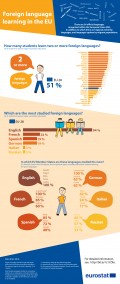Foreign Language Learning in Upper Secondary General Education in 2014 in EU-28
Currently there are 24 official languages recognised within the European Union (EU), in addition to which there are regional, minority languages, and languages spoken by migrant populations.
In 1958, legislation specified German, French, Italian and Dutch as the official and working languages of the European Union’s (EU) predecessor, the European Communities. There have always been fewer official languages than EU Member States, as some share common languages, for example in Belgium where the official languages are Dutch, French and German, while in Cyprus the majority of the population speaks Greek. Since Croatia’s accession there are 24 official languages recognised within the EU. In addition there are indigenous regional, minority languages (such as Catalan, Galician and Basque in Spain, or Welsh and Scottish Gaelic in the United Kingdom), and languages that have been brought into the EU by migrant populations, notably Arabic, Turkish, Urdu, Hindi and Chinese. Some regional languages, such as Catalan and Welsh, have gained a status as co-official languages of the EU and the official use of such languages can be authorised on the basis of an administrative arrangement concluded between the Council and the requesting EU Member State.
School and other educational institutions provide the main opportunity for the vast majority of people to learn languages, while linguistic diversity is actively encouraged within many further education establishments and workplaces. This article presents statistics on language learning in primary and secondary schools of the EU Member States, EFTA and candidate countries.
For more information read the article


